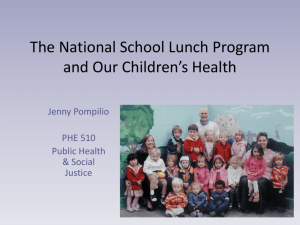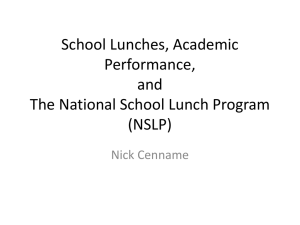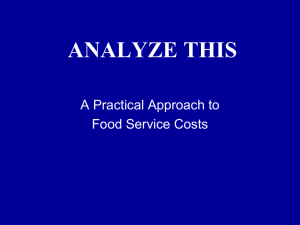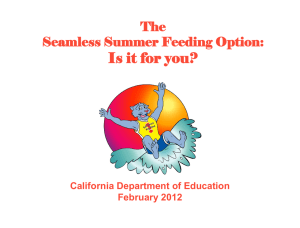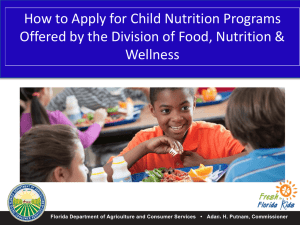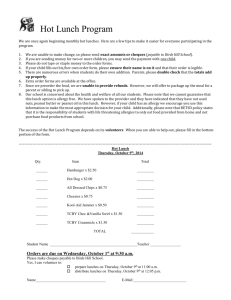Document 6619411
advertisement
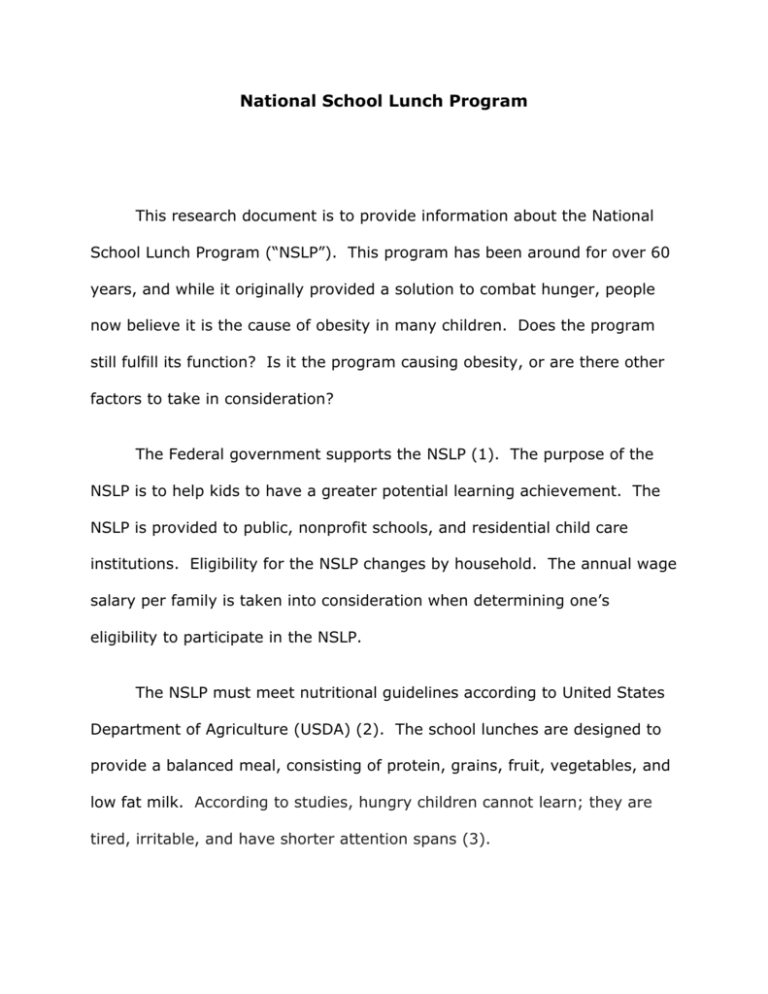
National School Lunch Program This research document is to provide information about the National School Lunch Program (“NSLP”). This program has been around for over 60 years, and while it originally provided a solution to combat hunger, people now believe it is the cause of obesity in many children. Does the program still fulfill its function? Is it the program causing obesity, or are there other factors to take in consideration? The Federal government supports the NSLP (1). The purpose of the NSLP is to help kids to have a greater potential learning achievement. The NSLP is provided to public, nonprofit schools, and residential child care institutions. Eligibility for the NSLP changes by household. The annual wage salary per family is taken into consideration when determining one’s eligibility to participate in the NSLP. The NSLP must meet nutritional guidelines according to United States Department of Agriculture (USDA) (2). The school lunches are designed to provide a balanced meal, consisting of protein, grains, fruit, vegetables, and low fat milk. According to studies, hungry children cannot learn; they are tired, irritable, and have shorter attention spans (3). Inappropriate nutrition affects the entire body, including mood and behavior, and kids who do not have an appropriate intake of energy are likely to suffer from behavioral problems, such as aggression and anxiety. Children who eat a healthy breakfast and lunch are more likely experience higher academic achievement than those who do not (4). According to a study done by Iowa State University, the results confirmed that school lunches improve health outcomes for children of lowincome families (4). Many low-income children do not have enough access to food throughout the day; affecting their ability for academic achievement. The study selected children, ages 6-17, to see if the kids would benefit from the NSLP. The results indicated that children, who have better access to food throughout the day, have a stronger potential to perform better and more consistent attendance at school. This study, based on its results, emphasizes that a good lunch is essential for academic success. The research by Iowa State University emphasizes that children enrolled in the NSLP, are likely to be obese; but is not because of the food provided by the NSLP (4). It is more likely that the children come from lower-income households where obesity is the problem. Research performed in 2005 by California Health Interview inspected the association between dietary behaviors. Children enrolled in the NSLP were analyzed, and the study indicated that those children were more likely to eat healthier then some kids who brought lunch from home. (4,5). However, children who brought lunch from home were less likely to eat fast food, and their intake of fruit and vegetables was greater. Students who brought their lunch to school consumed 0.35% less fast food, 0.35% less soda, 0.25% less of high-sugar foods, and 0.95% more servings of fruit and vegetables per day, when compared to students who never brought their lunch to school. The results from California Health Interview concluded that students who bring lunches from home have better overall eating behavior than adolescents who get their lunches from other sources. According to a research by Pediatric and Adolescent Medicine, their data concludes that girls who participated in the NSLP gained a lot of weight; just as much as girls from low-income households who do not get the subsidized lunches at school (6,7). According to the data from the study, about 36% of kids, ages 6 to 11, are overweight and 20% are considered obese. Excess body weight in children can likely lead to health problems, such as an increased risk of heart disease, diabetes, earlier onset puberty and cancer (7). Studies have found that kids who are part of the NSLP get more protein, vitamins, and minerals in their diets (8). However, studies have also found that these kids also consume more dietary fat and more calories overall. In addition, some studies have found that kids in the NSLP tend to be overweight or obese. A study from Penn State University focused on the Body Mass Index (BMI) of kids in the NSLP, and children who are not on the NSLP (6). For the study, 574 girls and 566 boys were selected across the country to enroll in the Early Childhood Longitudinal Study as kindergarteners in 1998. The researchers took children ages 5 to 14 years of age into consideration for this study. Their weights and heights were taken for assessing body mass index. The results of the study indicated that the average BMI for lowincome girls was the same as it was for the girls in the NSLP. They also noticed that the girls in the NSLP program gained weight fast, as soon as they began the NSLP. However, neither BMI nor weight appeared to affect boys in the NSLP (7). One fact that was taken into consideration was that the study done by Penn State University was done in a low-income school. So, even when the kids were not in the NSLP, they came from low-income households. These families tended to eat unhealthy fast foods and not exercise. School lunches have been criticized for a long time, and USDA is imposing new standards to encourage children to eat more fruits and vegetables. Many schools are regulating what can be sold at school; also known as “competitive foods” (8,9) Younger children, and adolescents, tend to buy lots of the competitive foods; which are extremely low in nutritional value and high in calories. The USDA is providing what it calls a “national baseline” for snacks in schools under the Healthy Hunger Free Kids Act of 2010, to combat childhood obesity. Also, the USDA is encouraging schools to join what is called the Healthier U.S. School Challenge (10). This program recognizes schools that are changing the nutritional quality of their school meals. This program builds on the USDA’s guidelines to improve the quality of meals provided at school. The Healthier U.S. School Program is not only encouraging quality meals and beverages for the students, but it also highly encourages physical activity for the students. Based on the information about the NSLP, it appears that it fulfill its purpose. Children of low-income families appear to be benefit from the NSLP. Studies show that kids who do not have enough food through the day cannot perform as well at school, and they can also develop behavioral issues. A couple studies emphasize that the NSLP is not the problem causing obesity. Obesity more likely stems from the families who tend to have unhealthy eating habits at home and lack physical activity. Also, the competitive foods have a lot to do with overweight and obese children. While the NSLP must follow a nutritional guideline, and appears to provide protein, fruit and vegetables, these foods also generally have more fat and calories. The Healthier U.S. Challenge is helping to achieve better meals at school, and is also emphasizing physical activity; since, after all, obesity results from poor nutrition and inactivity. The study from California Health Interview implies that healthy choices start at home. The study emphasizes that children that bring lunch from home have healthier eating behaviors overall. This study concludes that these children are being taught and expose to healthier choices at home. Many aspects have to be taken into consideration such as gender, age, environment, demographics, culture, religion, and physical activity in order to develop a sound conclusion since, in many case studies, a lot of these factors are left out. In the end, everything has an impact on children’s health and behavior. The schools and parents are responsible for the health of the children, and they must work together to improve childrens’ health and improve the NSLP. The NSLP is working on improving its services, but parental engagement is also required to help the NSLP evolve and provide better fresh, healthy, meals for the children. References 1. Food Research and Action Center. National School Lunch. http://frac.org/federal-foodnutrition-programs/national-school-lunch-program/. Accessed April 22, 2013. 2. United States Department of Agriculture Food and Nutrition Center. National School Lunch. http://www.fns.usda.gov/slp. Accessed April 22, 2013. 3. U.S. National School Lunch Program Improves Health of Children in Low-Income Households, Study Suggests. Science Daily. 2011. Accessed April 24, 2013. http://www.sciencedaily.com/releases/2011/11/111110142106.htm 4. National School Lunch Program Increases Educational Achievement, Study Finds. Science Daily. 2010. http://www.sciencedaily.com/releases/2010/06/100621121258.htm. Accessed April 24, 2013. 5. Snelling AM, Korba C, Burkey A. The National School Lunch and competitive food offerings and purchasing behaviors of high school students. (Research Article)(Report). Highbeam Research. 2007. http://www.highbeam.com/doc/1G1-172777221.html. Accessed April 26, 2013. 6. The National School Lunch Program. Mendeley. 1969. http://www.mendeley.com/research/national-school-lunch-program-3/. Accesed April 26, 2013. 7. Hernandez DC, Francis LA, Doyle EA. National School Lunch Program Participation and Sex Differences in Body Mass Index Trajectories of Children From Low-Income Families. Jama Pediatrics. 2011. http://archpedi.jamanetwork.com/article.aspx?articleid=384487. Accessed April 26, 2013. 8. My Fox Orlando. Junk Food Laws in Schools may Mean Healthier Kids. http://www.myfoxorlando.com/story/19262258/junk-food-laws-in-schoolsmay-mean-healthier-kids-study. Accessed April 26, 2013. 9. Rainville A, Choi K, Brown D. Healthy School Nutrition Environments: Views of School Foodservice Personnel Compared to Other School Personnel. The journal of child nutrition and Management. 2005. http://docs.schoolnutrition.org/newsroom/jcnm/05fall/rainville/index.asp. Accessed April 26, 2013. 10. Healthier US Challenge. United States Department of Agriculture Food and Nutrition Center. 2012. http://www.fns.usda.gov/tn/HealthierUS/vision.html. Accesed April 19, 2013.
